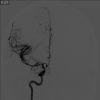Posterior communicating artery injury and symptomatic vasospasm after high-energy blunt head injury: illustrative case
- PMID: 35855314
- PMCID: PMC9241346
- DOI: 10.3171/CASE2053
Posterior communicating artery injury and symptomatic vasospasm after high-energy blunt head injury: illustrative case
Abstract
Background: Most of the published literature pertaining to blunt traumatic cerebrovascular injury (BCVI) is focused on extracranial arterial injury. Studies of intracranial arterial injury are relatively uncommon.
Observations: The clinical course of a patient who sustained an injury to the right posterior communicating artery followed by infarction due to vasospasm after severe traumatic brain injury is presented, along with a focused literature review.
Lessons: Intracranial BCVI is uncommon, and this report may serve to raise awareness of BCVI management and the importance of recognizing symptomatic vasospasm due to BCVI.
Keywords: BCVI = blunt traumatic cerebrovascular injury; CT = computed tomography; CTA = computed tomography angiogram; DSA = digital subtraction angiography; ICA = internal carotid artery; ICP = intracranial pressure; MCA = middle cerebral artery; NICU = neurological intensive care unit; PComm = posterior communicating artery; SAH = subarachnoid hemorrhage; aSAH = aneurysmal subarachnoid hemorrhage; blunt traumatic cerebrovascular injury; cerebral artery avulsion; severe traumatic brain injury; symptomatic vasospasm; tSAH = traumatic subarachnoid hemorrhage; traumatic subarachnoid hemorrhage.
© 2021 The authors.
Conflict of interest statement
Disclosures The authors report no conflict of interest concerning the materials or methods used in this study or the findings specified in this paper.
Figures





Similar articles
-
Risk factors for traumatic blunt cerebrovascular injury diagnosed by computed tomography angiography in the pediatric population: a retrospective cohort study.J Neurosurg Pediatr. 2015 Jun;15(6):599-606. doi: 10.3171/2014.11.PEDS14397. Epub 2015 Mar 6. J Neurosurg Pediatr. 2015. PMID: 25745952
-
Blunt cerebrovascular injuries in severe traumatic brain injury: incidence, risk factors, and evolution.J Neurosurg. 2017 Jul;127(1):16-22. doi: 10.3171/2016.4.JNS152600. Epub 2016 Jul 29. J Neurosurg. 2017. PMID: 27471889
-
Extent of collateralization predicting symptomatic cerebral vasospasm among pediatric patients: correlations among angiography, transcranial Doppler ultrasonography, and clinical findings.J Neurosurg Pediatr. 2015 Mar;15(3):282-90. doi: 10.3171/2014.9.PEDS14313. Epub 2015 Jan 2. J Neurosurg Pediatr. 2015. PMID: 25555113
-
Transcranial Doppler ultrasonography in neurological surgery and neurocritical care.Neurosurg Focus. 2019 Dec 1;47(6):E2. doi: 10.3171/2019.9.FOCUS19611. Neurosurg Focus. 2019. PMID: 31786564 Review.
-
Use of computed tomography in the emergency room to evaluate blunt cerebrovascular injury.Adv Surg. 2012;46:205-17. doi: 10.1016/j.yasu.2012.03.003. Adv Surg. 2012. PMID: 22873041 Review.
References
-
- Dubey A, Sung WS, Chen YY, et al. Traumatic intracranial aneurysm: a brief review. J Clin Neurosci. 2008;15(6):609–612. - PubMed
-
- Zangbar B, Wynne J, Joseph B, et al. Traumatic intracranial aneurysm in blunt trauma. Brain Inj. 2015;29(5):601–606. - PubMed
-
- Raslan AA, Abougamil AB, Okasha M, et al. Diffuse traumatic subarachnoid hemorrhage mimicking aneurysmal bleeding secondary to ophthalmic artery avulsion: case report and review of the literature. World Neurosurg. 2020;143:513–517. - PubMed
-
- Prior A, Allegretti L, Melloni I, et al. Traumatic subarachnoid hemorrhage related to ophthalmic artery avulsion: a case report. Acta Neurochir (Wien) 2018;160(5):913–917. - PubMed
-
- Limbrick DD, Jr, Behdad A, Derdeyn CP, et al. Traumatic enucleation with avulsion of the ophthalmic artery resulting in aneurysm-like subarachnoid hemorrhage. J Neurosurg. 2009;111(4):653–657. - PubMed
Publication types
LinkOut - more resources
Full Text Sources
Miscellaneous

